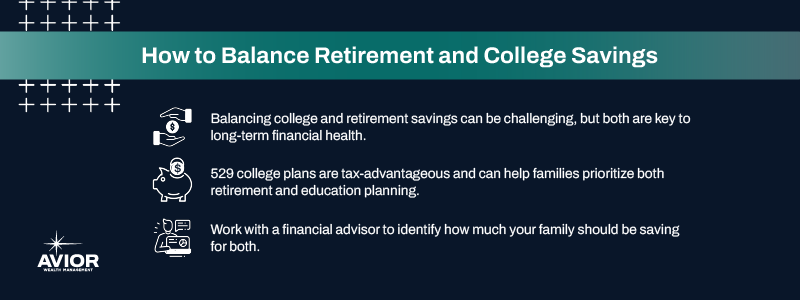How to Balance Retirement and College Savings
Both investments are important. Learn how to balance both for long-term financial health.

Saving your money is challenging enough, but how do you strike the right balance between retirement and college savings amidst economic uncertainty and tuition costs rising at an average of about 7% annually?
It’s by no means an easy feat, and most parents would agree: According to the 2024 College Savings Indicator report from Fidelity, parents care more about their kids’ college savings than they do their own retirement.
But it’s not about choosing one over the other; at least, it doesn’t have to be. Here, we’ll walk you through how to find that balance and secure a financially sound future for both yourself and your children.
Understanding Education Savings Accounts
Education savings accounts, or ESAs, make tax-advantaged college savings prone to long-term growth easier to achieve.
One of the most popular is the 529 College Savings Plan, which offers tax-deferred growth and tax-free withdrawals. They also come with high contribution limits that vary based on your state and lack education savings account income limits.
There are, however, a few education savings account rules to keep in mind. Recent legislation updates now allow 529 plan savings to be transferred to a Roth IRA for the beneficiary of the account, should they decide not to attend college down the road.
But if funds are to go toward education, they must be used for qualified education expenses, including tuition, room, and board expenses.
Retirement Savings Strategies
There’s no one-size-fits-all way to save for retirement. Several retirement savings strategies exist for you to use based on your goals and desired tax benefits. Two of the most popular retirement savings vehicles are the employer-sponsored 401(k) and the individual retirement account (IRA).
The sooner you start saving for retirement, the better, since you want to maximize the compound interest that both of these accounts provide. Keep this in mind when determining how much to save for retirement each month.
In general, traditional 401(k)s and IRAs use pre-tax dollars for contributions, but withdrawals in retirement are subject to income tax.
Roth accounts allow you to pay taxes on contributions now so that withdrawals are tax-free later. 401(k)s have higher annual contribution limits ($23,000 in 2024 or $30,500 if 50 and older), while IRA limits are lower ($7,000 in 2024, or $8,000 if 50 or older).
Use an online retirement calculator to figure out what you need to start saving to be able to afford the retirement you want. Strategize with a financial advisor to discuss best practices for retirement savings. Consider year-over-year inflation and life expectancy.
Some recommend a basic rule of thumb to save between 10% and 15% of your income if you start saving in your 20s or 30s to afford the retirement lifestyle that you want.
How to Balance Retirement and College Savings
Now that you’re familiar with popular college and retirement savings strategies, how do you strike the best balance between the two?
Here are a few strategies you can use.
1. Assess Your Circumstances
Every individual or family has different needs and goals. Consider factors like age, family size, and income level when determining how much to assign to each category.
For example, if you have multiple children who will likely attend college, you may decide to put more of your income into college savings accounts early on, then ramp up your retirement contributions as they finish college.
2. Leverage Tax Benefits and Incentives
The IRS offers several tax incentives for retirement and college savings. Use these to your advantage: They can help you multiply savings for both areas, so you can rest assured you’re saving enough.
3. Research Alternative College Funding Options
Remember that colleges and universities offer several ways to cover costs. These include but are not limited to scholarships, grants, work-study programs, and student loans.
Relying on these alternate funding sources can help you ease your savings burden.
4. Create a Thorough Financial Plan
Sit down with your financial advisor to discuss your long-term strategy. Set specific goals for retirement and college savings.
This can help you assess what’s realistic for your family and devise ways to measure progress and achieve your goals.
5. Don’t Overlook Rising Tuition Costs
Retirement account balances go up and down based on what’s happening in the economy. With college savings, the data shows that we can reasonably expect costs to steadily increase each year.
Factor in these increasing tuition costs when creating your savings plan.
6. Use a 529 for Both Retirement and College
Here’s another perk of 529 plans: You can have more flexibility with your savings.
As mentioned earlier, a new law—SECURE Act 2.0—allows you to move 529 savings you haven’t used into an IRA for the plan’s beneficiary.
This helps your children get a head start on their retirement savings.
7. Review and Adjust Your Investments Regularly
No matter what accounts you use for savings and how much you save each month, review your plan regularly.
Ever-changing circumstances will likely impact how much you save for retirement versus your kids’ college educations.
Find the Best Balance With Help From Avior
Saving for college and investing in retirement are both incredibly important. Finding the right balance between the two depends on your goals and circumstances, but it is possible to prioritize both with the right strategy.
With Avior’s wealth management services, you’ll work with an expert advisor who’s committed to understanding your family’s unique goals, circumstances, and long-term lifestyle desires.
Set up a consultation with our team to learn more about how we can help you balance both retirement and education planning.
Disclaimer: Nothing contained herein should be construed as legal or tax advice. Avior and our Advisors will work with your attorney and/or tax professional to assist with your legal and tax strategies. Please consult your attorney or tax professional with specific legal and/or tax questions. Investment Management and Financial Planner are offered through Avior Wealth Management, LLC, an SEC-registered investment advisor. Past performance is not a guarantee of future results. Investments are subject to loss, including the loss of principal.
No Comments
Sorry, the comment form is closed at this time.




